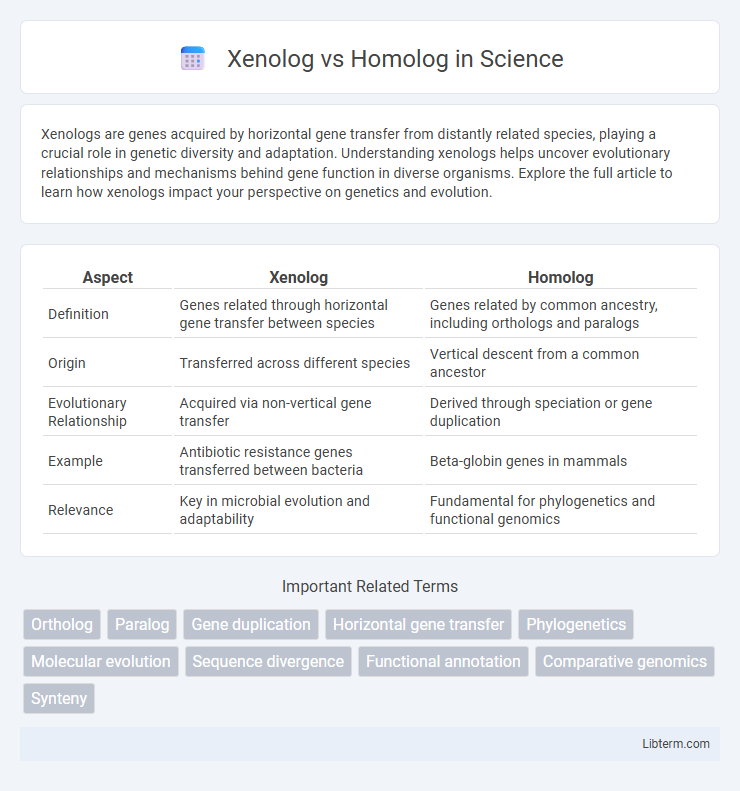Xenologs are genes acquired by horizontal gene transfer from distantly related species, playing a crucial role in genetic diversity and adaptation. Understanding xenologs helps uncover evolutionary relationships and mechanisms behind gene function in diverse organisms. Explore the full article to learn how xenologs impact your perspective on genetics and evolution.
Table of Comparison
| Aspect | Xenolog | Homolog |
|---|---|---|
| Definition | Genes related through horizontal gene transfer between species | Genes related by common ancestry, including orthologs and paralogs |
| Origin | Transferred across different species | Vertical descent from a common ancestor |
| Evolutionary Relationship | Acquired via non-vertical gene transfer | Derived through speciation or gene duplication |
| Example | Antibiotic resistance genes transferred between bacteria | Beta-globin genes in mammals |
| Relevance | Key in microbial evolution and adaptability | Fundamental for phylogenetics and functional genomics |
Understanding Gene Relationships: Xenologs vs Homologs
Xenologs are genes related through horizontal gene transfer, while homologs share common ancestry due to vertical descent. Understanding gene relationships involves distinguishing xenologs, which arise from gene transfer between different species, from homologs that originate from a common ancestral gene within a species lineage. This distinction is crucial for accurate evolutionary analysis and functional gene annotation.
Defining Xenologs: Origin and Characteristics
Xenologs are genes related by horizontal gene transfer between different species rather than vertical inheritance from a common ancestor, distinguishing them from homologs that share ancestry through speciation or gene duplication. Originating from processes such as bacterial conjugation, viral transduction, or transformation, xenologs often exhibit sequence similarities despite their presence in phylogenetically distant organisms. These genes are characterized by their irregular phylogenetic distribution and can play crucial roles in adaptive evolution by introducing new functions across species barriers.
What Are Homologs? Fundamental Concepts
Homologs are genes or proteins that share a common ancestral origin, reflecting evolutionary relatedness across different species or within the same genome. They are classified into orthologs, which diverged after a speciation event, and paralogs, which arose from gene duplication within a species. Understanding homologs is fundamental in comparative genomics and functional annotation, as they reveal conserved functions and evolutionary relationships.
Key Differences Between Xenologs and Homologs
Xenologs and homologs both refer to genes related by descent but differ in their origin; homologs arise from a common ancestor through speciation or gene duplication, while xenologs result from horizontal gene transfer between species. Key distinctions include the mechanism of gene transfer, with homologs inherited vertically within lineages and xenologs acquired horizontally across species boundaries. Functional divergence varies as homologs often retain similar biological roles, whereas xenologs may acquire novel functions due to their distinct evolutionary paths.
Mechanisms of Xenolog Formation: Horizontal Gene Transfer
Xenologs arise through horizontal gene transfer mechanisms such as conjugation, transformation, and transduction, enabling genes to move between distinct species and contribute to genetic diversity. In contrast, homologs result from vertical descent, maintaining evolutionary lineage through gene duplication or speciation events. Horizontal gene transfer in xenolog formation plays a critical role in rapid adaptation and the acquisition of novel functions across microbial populations.
Functional Implications: Xenologs vs Homologs in Evolution
Xenologs arise from horizontal gene transfer between different species, often introducing novel functions that can drive adaptive evolution in new environmental contexts. Homologs, derived from a common ancestral gene through speciation or gene duplication, typically retain core functions while allowing divergence for specialized roles in related organisms. Understanding the functional implications of xenologs versus homologs is crucial for interpreting evolutionary innovation and the mechanisms of gene function diversification.
Phylogenetic Analysis: Identifying Xenologs and Homologs
Phylogenetic analysis distinguishes xenologs and homologs by tracing gene lineage across species, where homologs share a common ancestral gene inherited vertically, while xenologs arise from horizontal gene transfer events between unrelated species. Constructing evolutionary trees using sequence alignment and comparative genomics reveals branching patterns that differentiate homologous gene duplication from xenologous transfer. Accurate identification of xenologs versus homologs enhances understanding of gene evolution, functional divergence, and ecological adaptation.
Xenologs and Homologs in Comparative Genomics
Xenologs are genes acquired through horizontal gene transfer between different species, playing a crucial role in comparative genomics by revealing evolutionary events that deviate from vertical inheritance. Homologs, including orthologs and paralogs, are genes related by descent from a common ancestor, providing foundational insights into gene function and evolutionary relationships. Identifying xenologs alongside homologs enhances understanding of genome plasticity, adaptation, and the mechanisms driving genetic diversity across species.
Real-World Examples of Xenologs and Homologs
Xenologs are genes acquired through horizontal gene transfer between different species, commonly observed in bacteria such as antibiotic resistance genes transferred via plasmids in Escherichia coli. Homologs, on the other hand, arise from a common evolutionary ancestor, with examples including the hemoglobin genes in humans and mice that share significant sequence similarity due to divergent evolution. Comparative genomics studies frequently use these gene types to distinguish between vertical inheritance and horizontal gene transfer events in various organisms.
The Importance of Distinguishing Xenologs from Homologs in Research
Distinguishing xenologs from homologs is crucial for accurate evolutionary analysis and gene function prediction, as xenologs arise from horizontal gene transfer while homologs result from common ancestry. Misidentifying xenologs as homologs can lead to incorrect inferences about species evolution and gene inheritance patterns. Correct classification enhances the understanding of genome dynamics and the role of horizontal gene transfer in adaptation and innovation.
Xenolog Infographic

 libterm.com
libterm.com